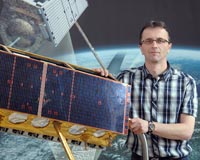 |
Pasadena CA (JPL) Nov 03, 2010 The seven-month upgrade to the historic "Mars antenna" at NASA's Deep Space Network site in Goldstone, Calif. has been completed. After a month of intensive testing, similar to the rehabilitation stage after surgery, the antenna is now ready to help maintain communication with spacecraft during the next decade of space exploration. The month of October was used as a testing period to make sure the antenna was in working order and fully functional, as scheduled, for Nov. 1. A team of workers completed an intense series of tasks to reach its first milestone - upgrading the 70-meter-wide (230-foot-wide) antenna in time to communicate with the EPOXI mission spacecraft during its planned flyby of comet Hartley 2 on Nov. 4. The first official demonstration space track was on Sept. 28, when the antenna communicated with NASA's EPOXI mission spacecraft. "We've been testing the antenna since Sept. 28, and we've had no problems in tracking the spacecraft," said Peter Hames of NASA's Jet Propulsion Laboratory, Pasadena, Calif., who is responsible for maintaining the network's antennas. "We are ready to resume service as scheduled." JPL manages the Deep Space Network for NASA. During the upgrade process, workers raised a portion of the antenna that weighs 3.2 million kilograms (7 million pounds) up from the base by 5 millimeters (0.2 inches) while they performed a precise, delicate repair. They replaced a portion of the hydrostatic bearing (enabling the antenna to rotate horizontally) and the four elevation bearings (enabling the antenna to track up and down from the horizon). Unlike the sterile confines of an operating room, this surgery took place in the middle of California's Mojave Desert, a hot oasis baked by the unforgiving desert heat. The team members were able to cheat the heat by completing a number of the 375 tasks during early morning and night shifts. The tasks required the team to analyze, load, lift, install, test, analyze again and inspect. The Deep Space Network consists of three deep-space communication facilities positioned approximately 120 degrees of longitude apart. In addition to the Mojave Desert location at Goldstone, the other locations are outside of Madrid, Spain, and Canberra, Australia. Each 70-meter (230-foot) antenna is capable of tracking a spacecraft traveling more than 16 billion kilometers (10 billion miles) from Earth. The antennas are strategically situated at each location in semi-mountainous basins to reduce radio frequency interference. This careful placement helps make the Deep Space Network the largest and most sensitive science telecommunications system in the world. In March 1966, the antenna, officially known as Deep Space Station 14, earned its nickname as the Mars antenna by receiving the first signal from NASA's Mariner 4 mission to Mars. The historic dish is now responsible for tracking an entire fleet of missions, including the rovers Spirit and Opportunity currently on the surface of Mars, the Cassini orbiter at Saturn, the twin Voyager spacecraft in the outer reaches of our solar system, and the Spitzer Space Telescope, which observes stars, galaxies and other celestial objects. "We are nearing the completion of a very challenging engineering effort that will extend the life of one of the DSN's workhorses, making it more available and reliable in returning critical science data through at least 2025," said Wayne Sible, the network's deputy project manager at JPL. The antenna upgrade was a collaborative effort between JPL, Diani Building Corp., Santa Maria, Calif., and ITT Corp., White Plains, N.Y. Their shared goal was to emerge from the "operating room" with a healthy patient. "The 70-meter antenna gets under your skin, everyone involved in this project was so passionate about it, from the grout workers to the machine shops to the guys on the antenna, everybody was giving it their absolute all," said Hames.
Share This Article With Planet Earth
Related Links Deep Space Network at JPL Space Technology News - Applications and Research
 TanDEM-X Leader Has A Connection With Antennas
TanDEM-X Leader Has A Connection With AntennasBerlin, Germany (SPX) Oct 12, 2010 Manfred Zink likes to organise things. For the TanDEM-X radar satellite mission he is organising when and where the antennas of the satellites are to point, in order to acquire the best three-dimensional images possible of our planet. Manfred Zink is Project Manager for the Ground Segment of the mission at the German Aerospace Center in Oberpfaffenhofen. He is responsible for directing the ... read more |
|
| The content herein, unless otherwise known to be public domain, are Copyright 1995-2010 - SpaceDaily. AFP and UPI Wire Stories are copyright Agence France-Presse and United Press International. ESA Portal Reports are copyright European Space Agency. All NASA sourced material is public domain. Additional copyrights may apply in whole or part to other bona fide parties. Advertising does not imply endorsement,agreement or approval of any opinions, statements or information provided by SpaceDaily on any Web page published or hosted by SpaceDaily. Privacy Statement |